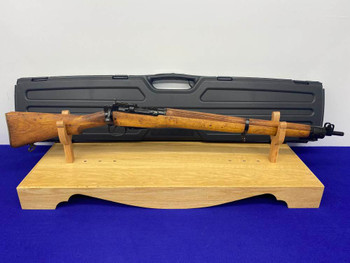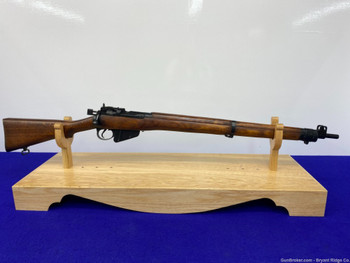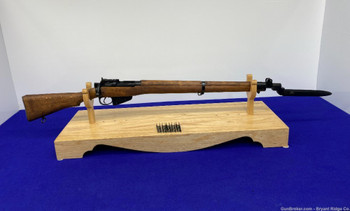Description
Item Description
Bryant Ridge Auction Company is pleased to present this incredible bolt-action rifle today for a penny-start auction, this is the Savage No.4 MK 1/3"!
This particular model was originally a Savage No.4 MKI*, which was refurbished to the No.4 MK2 Specifications in 1952 and renamed the No.4 MK 1/3!
SPECIFICATIONS:
Manufacturer: Savage
Model: No.4 MKI* “Refurbished to the No.4 MK2 Specs, then renamed the No.4 MK 1/3”
Serial: 51C4336
Date of Manufacture: Refurbished in 1952
Caliber: .303 British
Finish: Black
Barrel Length: 25 1/4"
Optics/Sights: Winged Protected Blade Front with Fold Adjustable Aperture Rear
Stock/Grips: Smooth Walnut
Action: Bolt-Action
Markings: Standard / The left side of the receiver is stamped "No4 MK1/3 (F) FTR /52. 51C4336" and “S NO.4 MK I*”. The top of the receiver is stamped “U.S. Property”. Under the barrel is stamped with British-proof marks.
Bryant Ridge's Analysis:
By the late 1930s, the need for new rifles grew, and the Rifle, No. 4 Mk I was officially adopted in 1941. The No. 4 action was similar to the No.1 Mk VI but stronger and easier to mass-produce. Unlike the SMLE, which had a nose cap, the No 4 Lee–Enfield barrel protruded from the end of the forestock. For easier machining, the charger bridge was no longer rounded. The iron sight line was redesigned and featured a rear receiver aperture battle sight calibrated for 300 yd (274 m) with an additional ladder aperture sight that could be flipped up and was calibrated for 200–1,300 yd (183–1,189 m) in 100 yds (91 m) increments. This sight, like other aperture sights, proved to be faster and more accurate than the typical mid-barrel open rear sight elements sight lines offered by Mauser, previous Enfields, or the Buffington battle sight of the M1903 Springfield.
The No. 4 rifle was heavier than the No. 1 Mk. III, largely due to its heavier barrel. A new bayonet was designed to go with the rifle: a spike bayonet, the No. 4 bayonet, essentially a steel rod with a sharp point, nicknamed "pigsticker" by soldiers. Towards the end of the Second World War, a bladed bayonet was developed for the No.5 Mk.I rifle ("jungle carbine"). Post-war versions were made that would fit No. 4 rifles and were designated No. 7 and No. 9 blade bayonets. During the course of the Second World War, the No. 4 rifle was further simplified for mass production with the creation of the No. 4 Mk I* in 1942, with the bolt release catch replaced by a simpler notch on the bolt track of the rifle's receiver. It was produced only by Small Arms Limited at Long Branch in Canada and Stevens-Savage Firearms in the US. The No.4 rifle was primarily produced for the United Kingdom, Canada, and some other Commonwealth countries, including New Zealand. In 1943, it cost £7 15s (£7.75) to produce. By comparison, a Sten Mk II submachine gun cost £2 10s (£2.50). With the introduction of the No. 4 Mk 2 rifle, the British refurbished many of their No. 4 rifles and brought them up to the same standard as the No. 4 Mk 2. The No. 4 Mk 1 rifles were renamed No. 4 Mk I/2, while No. 4 Mk I* rifles that were brought up to Mk 2 standard were renamed No. 4 Mk I/3.
Return Policy:
We gladly offer a 3 day unfired inspection policy from the time that the firearm is delivered to your FFL. Refunds are available for all qualifying orders.
Model: No.4 MKI* “Refurbished to the No.4 MK2 Specs, then renamed the No.4 MK 1/3”
Serial: 51C4336
Date of Manufacture: Refurbished in 1952
Caliber: .303 British
Finish: Black
Barrel Length: 25 1/4"
Optics/Sights: Winged Protected Blade Front with Fold Adjustable Aperture Rear
Stock/Grips: Smooth Walnut
Action: Bolt-Action
Markings: Standard / The left side of the receiver is stamped "No4 MK1/3 (F) FTR /52. 51C4336" and “S NO.4 MK I*”. The top of the receiver is stamped “U.S. Property”. Under the barrel is stamped with British-proof marks.
Bryant Ridge's Analysis:
By the late 1930s, the need for new rifles grew, and the Rifle, No. 4 Mk I was officially adopted in 1941. The No. 4 action was similar to the No.1 Mk VI but stronger and easier to mass-produce. Unlike the SMLE, which had a nose cap, the No 4 Lee–Enfield barrel protruded from the end of the forestock. For easier machining, the charger bridge was no longer rounded. The iron sight line was redesigned and featured a rear receiver aperture battle sight calibrated for 300 yd (274 m) with an additional ladder aperture sight that could be flipped up and was calibrated for 200–1,300 yd (183–1,189 m) in 100 yds (91 m) increments. This sight, like other aperture sights, proved to be faster and more accurate than the typical mid-barrel open rear sight elements sight lines offered by Mauser, previous Enfields, or the Buffington battle sight of the M1903 Springfield.
The No. 4 rifle was heavier than the No. 1 Mk. III, largely due to its heavier barrel. A new bayonet was designed to go with the rifle: a spike bayonet, the No. 4 bayonet, essentially a steel rod with a sharp point, nicknamed "pigsticker" by soldiers. Towards the end of the Second World War, a bladed bayonet was developed for the No.5 Mk.I rifle ("jungle carbine"). Post-war versions were made that would fit No. 4 rifles and were designated No. 7 and No. 9 blade bayonets. During the course of the Second World War, the No. 4 rifle was further simplified for mass production with the creation of the No. 4 Mk I* in 1942, with the bolt release catch replaced by a simpler notch on the bolt track of the rifle's receiver. It was produced only by Small Arms Limited at Long Branch in Canada and Stevens-Savage Firearms in the US. The No.4 rifle was primarily produced for the United Kingdom, Canada, and some other Commonwealth countries, including New Zealand. In 1943, it cost £7 15s (£7.75) to produce. By comparison, a Sten Mk II submachine gun cost £2 10s (£2.50). With the introduction of the No. 4 Mk 2 rifle, the British refurbished many of their No. 4 rifles and brought them up to the same standard as the No. 4 Mk 2. The No. 4 Mk 1 rifles were renamed No. 4 Mk I/2, while No. 4 Mk I* rifles that were brought up to Mk 2 standard were renamed No. 4 Mk I/3.
Return Policy:
We gladly offer a 3 day unfired inspection policy from the time that the firearm is delivered to your FFL. Refunds are available for all qualifying orders.
Shipping Details
Handgun Standard Shipping with Insurance $50.00
Long Gun Standard Shipping with Insurance $70.00
Any orders placed with magazines that are not compliant with your state, county, or city regulations will not ship with your order.
We strive to ship orders within the close of the following business day after payment and documentation is received.
Payment Details
We accept all forms of Payment including Personal Check, Business Check, PO Money Orders, Certified Check, Etc.
Please note we place a 7 business day hold on shipment, for all non-certified payments.
Payment MUST be received within 14 days.
Return Policy
We gladly offer a 3 day unfired inspection policy from the time that the firearm is delivered to your FFL. Refunds are available for all qualifying orders.
Additional Details
Our #1 priority is customer satisfaction. We want to build a lasting trust in the relationship with our customers, so that you will always look to us for all your firearms needs. If you have any issues with your transactions please contact us, and we will work with you to resolve any issues you may have. We greatly appreciate your trust in us and we look forward to fulfilling all your future firearm needs.
Bryant Ridge also reserves the right to cancel any sales that may occur while gunbroker.com is experiencing technical issues that affects the entire site or a complete site outage, within an hour of the auction ending.
We have an amazing inventory of classic and collector firearms that we are adding to Gunbroker daily. Stay up to date on all of our latest auction by adding us to your favorite sellers list.
About Us
From a small town hobby, to a leader in the investment and collector grade firearms industry. Bryant Ridge Firearms is here to offer the best in quality and customer service when you are looking to unload your collector grade firearm collection.
















